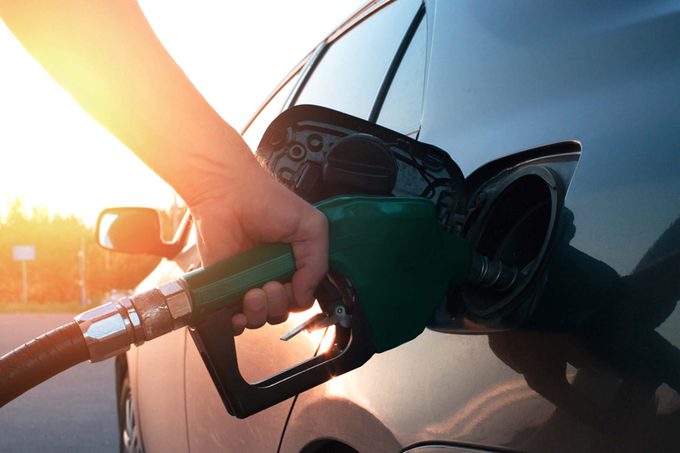Just got a new car and already forgot which side the gas tank’s on? Here are the reasons why cars have fuel doors on different sides.

Why Do Cars Have Fuel Doors on Different Sides?

Do car engineers draw straws to decide which side of the car the fuel door goes on? No—but it sure feels like it. If you’ve ever sat in a car other than yours, squinting at the dashboard and trying to remember which side the fuel door is on, you’ve probably asked yourself one question: Why do cars have fuel doors on different sides? (Well, one question after “What side is the darn gas tank on?!”)
It may feel like there should be a clear reason for the inconsistent design, and maybe even an advantage to one side over the other, but the truth is a bit more complicated. Ahead, we delve into why gas tanks aren’t always on the same side.
Get Reader’s Digest’s Read Up newsletter for more news, tech, travel, cleaning, humor and fun facts all week long.
Where are gas tanks located on cars?
As anticlimactic as it may sound, the answer is that there’s no fixed side for a gas tank on a car. And while some automotive companies tend to lean toward a particular side—left for Japanese manufacturers like Toyota and Honda, and right for German car brands like BMW and Audi—there are always some models within each brand that have gas tanks on different sides. Case in point: Toyota’s Corolla, which usually has its gas tank on the car’s left side in the United States, features a right-side gas tank in some parts of Europe and Australia.
But exactly why are gas tanks on different sides? Well, our straw-drawing theory isn’t correct, but there are many other reasons for the gas tank’s placement. Keep reading for the details.
Why do cars have fuel doors on different sides?
Now that we know gas tanks in cars are on different sides depending on which car brand and model you’re looking at, let’s delve into the details.
Convenience (for car designers)
Engineers are free to place fuel doors on the side of the car that offers the easiest packaging, Ford spokesman Mark Schirmer told Allstate insurance company. And while one on each side would be rather convenient, we’re not likely to see dual fuel doors anytime soon—there’s neither the room nor the demand for them.
Design functionality
“The placement of the fuel door is mainly a factor of fuel tank design, location and underbody packaging,” Nissan’s Steve Yaeger told Allstate. “With all of the structure and components located underneath the vehicle, [engineers] would quickly encounter restrictions in trying to route the filler tube to the same side on every vehicle.” This is a solid reason why there’s no universal standard for gas tanks in cars.

Driver preference
Schirmer also says that Americans prefer fuel doors on the left side of their cars, probably because it makes it easier for them to place their car’s left fender close to the fuel pump. For this reason, it’s possible that drivers in the U.K., Australia, New Zealand, India and other countries that drive on the left side of the road favor a right-side fuel door (although multiple models driven in these countries feature gas tanks on different sides). Ultimately, there’s nothing to confirm that driver preference is the deciding factor in fuel door location.
Local regulations
Across countries, there are some regulations about where the fuel door should be positioned, but these don’t specify the right or left side of the car. Current U.S. regulations on car fuel systems demand the filler be at the widest part of a car, inboard of any crumple zones and safe from dripping onto any hot exhaust bits or electrical wiring.
Equilibrium (or lack thereof)
PBS Newshour presented the “equilibrium” argument: If all cars had fuel doors on the same side, 50% of the pumps in the gas station would be unused, and we’d all spend even more of our time waiting in line to get gas. (Good point!)
Ultimately, if you can’t remember the location of your car’s fuel door (and if we’re completely honest, most of us will have to take a second and think about that before we answer), don’t stress. There’s a simple hack to help you out: Look at the little diamond-shaped arrow on the fuel gauge on your dashboard—it points to the side of the car where the fuel door is. And make sure to do it before you pull up to the pump, to avoid the embarrassment of having to get back into your car and drive to another pump.
Why trust us
At Reader’s Digest, we’re committed to producing high-quality content by writers with expertise and experience in their field in consultation with relevant, qualified experts. We rely on reputable primary sources, including government and professional organizations and academic institutions as well as our writers’ personal experiences where appropriate. We verify all facts and data, back them with credible sourcing and revisit them over time to ensure they remain accurate and up to date. Read more about our team, our contributors and our editorial policies.
Sources:
- Ibex Insurance: “Why Don’t All Cars Have Fuel Tanks on the Same Side?”
- Cornell Law School: “49 CFR § 393.65 – All fuel systems.”
- Allstate: “Fuel FAQs: Everything you need to know about filling up”
- PBS News: “Why Do Cars Have Fuel Doors on Different Sides?”


















